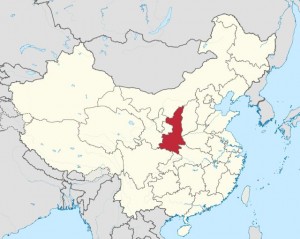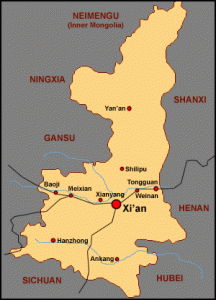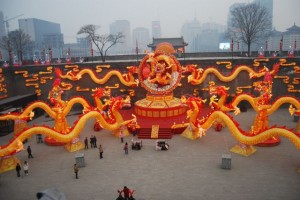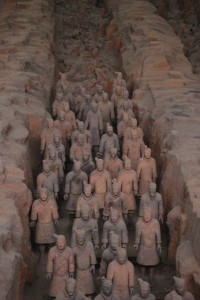Better Know a… Province (Shaanxi) Posted by sasha on Mar 3, 2013 in Culture, Vocabulary
From the southeast coast of China and Zhejiang province, we’re moving inland this time to explore Shaanxi province (陕西省 – shǎn xī shěng).
This province holds a special place in Chinese history and culture, as it was the site of the capital for many of China’s ancient dynasties. Its current capital city was once the starting point for the ancient Silk Road, and the province has a history going back thousands of years, which is where we’ll begin our tour:
Take a video tour through Shaanxi province.
History
Considered to be the cradle of Chinese civilization, it’s an understatement to say that Shaanxi has a long and important history. To take it all in, you can visit the Shaanxi History Museum in the capital city of Xi’an (西安 – xī’ān). There, you’ll find that fossils of Lantian Man (蓝田人 – lán tián rén), a subspecies of homo erectus that lived about a million years ago. Speaking of Xi’an, it is one of the Four Great Ancient Capitals of China (中国四大古都 – zhōng guó sì dà gǔ dū). The current name, meaning “Western Peace,” has remained since the Ming Dynasty. In dynasties past, the city used to be called Chang’an (长安 – cháng’ān), or “Perpetual Peace.” In all, thirteen feudal dynasties called the city their capital.
Geography
This inland province shares a border with: Shanxi, Hunan, Hubei, Chongqing, Sichuan, Gansu, Ningxia, and Inner Mongolia. It is composed of three distinct landforms. In the north, you’ll find the Loess Plateau (黄土高原 – huáng tǔ gāo yuán), which accounts for 45% of the total area of the province. In the south, you’ll find the Qin Mountains (秦岭 – qín lǐng) that run from east to west. In between lies the central Shaanxi plain, also known as Guanzhong (关中 – guān zhōng). With deserts, mountains, plains, valleys, rivers, waterfalls, and much more, Shaanxi is a very geographically diverse province. The province is split up into nine prefecture-level cities, and one sub-provincial city.
Climate
As Shaanxi province is very long from north to south, covering a large span of altitude, the province experiences a variety of climates. Up in the north, the climate is cold arid/cold semi-arid. Here, winter is very cold and dry, and summers are hot. In the Guanzhong region, the climate is mostly semi-arid, while some areas are considered to have a humid subtropical climate. Hot and humid summers here often see heat waves. As for the southern part of the province, it’s much more humid. Winters are nice and cool here, and the summers are hot and long.
Population
As of 2010, the population of Shaanxi clocks in at over 37 million. Mostly all of the people in Shaanxi are Han Chinese, although some clusters of Hui minority people live in the northwestern region, where the province shares a border with Ningxia. Not surprisingly, most people live in and around Xi’an, while the areas in the north and along the mountain ranges are sparsely populated.
Culture
When it comes to culture, one of the first things that comes to mind is Shaanxi cuisine (陕西菜 – shǎn xī cài). Known for its strong flavors, Shaanxi cuisine makes elaborate use of garlic, salt, onion, and vinegar. As for meat, pork and lamb are most commonly used. As opposed to rice, the staple of Shaanxi is definitely noodles, which are thicker and longer than most other varieties of Chinese noodles. One of the most famous dishes comes from Xi’an – crumbled bread soaked in mutton stew (羊肉泡馍 – yáng ròu pào mó). On a cold winter day, there’s nothing better than a big hot bowl of this delicacy.
Shaanxi is also famous for qinqiang (秦腔 – qín qiāng), a style of Chinese opera that originated thousands of years ago.
Famous Places
Of course, the ancient capital of Xi’an is the most famous place in the province. Thousands of tourists flock here everyday to see the sights, including the ancient City Wall (城墙 – chéng qiáng) and the Terra-Cotta Warriors (兵马俑 – bīng mǎ yǒng). Stroll along the City Wall and look down at Xi’an to see both the new and old city – locals playing cards in the park with cranes towering above.
Outside of the city, you’ll find the incredible Terra-Cotta Warriors. Discovered in 1974 by a farmer, this archaeological wonder features the army of soldiers and horses that were buried with the first Emperor of China, Qin Shi Huang (秦始皇). There are plenty of other notable sites in and around Xi’an city, such as the Muslim quarter, the Drum and Bell towers, the Wild Goose Pagoda, and much more. Shaanxi is also home to one of the Five Great Mountains of China, Mt. Hua (华山 – huà shān).
With an important spot in China’s history books, varied landscapes, dozens of fascinating sights, and delicious food, Shaanxi province is well worth exploring if you have the chance to visit China.

Build vocabulary, practice pronunciation, and more with Transparent Language Online. Available anytime, anywhere, on any device.
About the Author: sasha
Sasha is an English teacher, writer, photographer, and videographer from the great state of Michigan. Upon graduating from Michigan State University, he moved to China and spent 5+ years living, working, studying, and traveling there. He also studied Indonesian Language & Culture in Bali for a year. He and his wife run the travel blog Grateful Gypsies, and they're currently trying the digital nomad lifestyle across Latin America.









Comments:
Marco:
Hello Sasha, I have a question. I may be living in Xi’an as part of an exchange program next year, do people in that city speak English?
Sheila:
I’m lived in China for eight years.
It’s incredible.
Denis:
I’d like to visit China. Maybe incridible.
Bruno Silva:
My dream is to stroll in China one day, but in the meantime, I’m going to see imams and videos of the country!